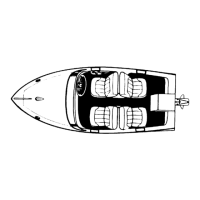90-823225--1 10965E-102 - ELECTRONIC FUEL INJECTION (MULTI-PORT AND THROTTLE BODY)
Code 21: Throttle Position (TP) Sensor Circuit (Scan)
(1 of 2)
TP
B
C
A
A
C
B
CIRCUIT DESCRIPTION:
The Throttle Position (TP) Sensor provides a voltage
signal that changes as throttle blades open or close.
Signal voltage should vary from about .7 volts at idle
to about 4.5 volts at Wide Open Throttle (W.O.T.).
The TP signal is one of the most important inputs
used by the Electronic Control Module (ECM) for fuel
control and for most of the ECM controlled outputs.
TEST DESCRIPTION:
Number(s) below refer to circled number(s) on the
diagnostic chart.
1. With throttle closed the TP sensor should read
between .3 and .8 volt. If it does not, check throttle
cable adjustment or for bent linkage.
2. With the TP sensor disconnected, the TP voltage
should go low if the ECM and wiring are OK.
3. Probing CKT 813 with a DVOM to CKT 416
checks the sensor ground. A faulty sensor
ground will cause a Code 21.
DIAGNOSTIC AIDS:
The scan tool reads throttle position in voltage and
percentage of throttle blade opening. With ignition
ON or at idle, TP signal voltage should read between
.3 and .8 volt with the throttle closed, and increase at
a steady rate as throttle is moved toward Wide Open
Throttle (W.O.T.).
If Code 23 is also set, check CKT 813 for faulty wiring
or connections. Check terminals at sensor for good
contact.
An intermittent problem may be caused by a poor or
corroded connection, rubbed through wire connec-
tion, a wire that is broken inside the insulation, or a
corroded wire.
Any circuitry that is suspected as causing the inter-
mittent complaint should be thoroughly checked for
backed-out terminals, improper mating, broken
locks, improperly formed or damaged terminals, poor
terminal-to-wiring connections, corroded terminals
and/or wiring, or physical damage to the wiring har-
ness. After repairs, clear codes following “Clearing
Codes” in “ECM Self-Diagnostics.” Failure to do so
may result in codes not properly being cleared.

